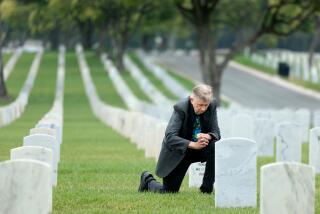Obituaries - March 16, 1999
- Share via
Al-Anoud bint Abdel Aziz; King Fahd’s Wife
Princess Al-Anoud bint Abdel Aziz, believed to be 76, first wife of King Fahd of Saudi Arabia. They were married as teenagers, and the princess gave birth to five of the king’s sons. He has a second wife, Princess Jawhara bint Ibrahim al-Ibrahim, who is the mother of Fahd’s youngest and favorite son, Prince Abdel-Aziz bin Fahd bin Abdel-Aziz. Princess Al-Anoud, who led an intensely private life, had been ill for two decades and had lived in the Bel-Air section of Los Angeles in recent years for treatment of a disease that affected her spinal cord and kidneys. On March 8 in Santa Monica of kidney failure.
Donna Carroll; International Photographer
Donna Carroll, 63, photographer who specialized in international scenes. As a freelance photographer in several countries, Carroll contributed dozens of photos to The Times, particularly from Mexico. Her work also appeared in several other newspapers and magazines. Last year, she received Mexico’s Lente de Plata prize for her work there. It was her sixth international photography award. Born in Los Angeles, Carroll was educated at the former Chouinard School of Art here. On March 6 in Sunland, Calif., of lung cancer.
Harry S. Franklin; Screenwriter and TV Director
Harry S. Franklin, 88, screenwriter and television director of such hit series as Lloyd Bridges’ “Sea Hunt.” A native of Kitchener, Canada, Franklin served in Army Special Services during World War II, shooting documentary films for Gen. Douglas MacArthur. He also wrote and directed many Army films about the division of Berlin after the war. Along with Merrill G. White, Franklin was credited with writing the screenplay for the 1956 film about bullfighting, “The Brave One.” Blacklisted writer Dalton Trumbo, using the name Robert Rich, won an Academy Award for best original story for that film. Trumbo received the statuette under his own name in 1975, a year before he died. Franklin and White were not nominated for their screenplay. Franklin directed the war film “Red Snow” and directed extensively for television, including episodes of “Cheyenne,” “Maverick,” “Meet McGraw,” “Cisco Kid” and “The Dennis O’Keefe Show.” On March 7 in Los Angeles.
Oswaldo Guayasamin; Ecuadorean Muralist
Oswaldo Guayasamin, 79, Ecuadorean muralist and outspoken critic of U.S. policy in Latin America. Called “the Michelangelo of the defeated race,” Guayasamin painted murals known for their Indian themes and angular faces with brooding eyes. His greatest and most anguished work was a series called “The Age of Wrath,” which depicted outsize hands cupping, pleading, protecting and beseeching. In August 1988 he unveiled a huge, 23-panel mural at the Ecuadorean Congress telling Ecuador’s history through portraits of heroes, dictators, images of suffering and a hopeful pair of hands reaching toward a pre-Columbian sun. The most controversial aspect of the work was a Nazi-style helmet enclosing a skeletal face, above which the artist inscribed the letters CIA. When then-Secretary of State George P. Shultz saw the reference to the Central Intelligence Agency during a visit to Quito, he denounced it as an insult to the United States. “This is my form of fighting,” Guayasamin, a committed leftist, said of his work. His paintings have been exhibited around the world, including at the Hermitage in St. Petersburg. He was one of only three artists, including Chagall and Picasso, to have his work displayed at the Paris Museum of Modern Art while still living. He lived in Quito but was traveling in the United States with his daughter when he was stricken. In Baltimore on Wednesday of a stroke.
Steven Holtzman; Author, Digital Arts Expert
Steven R. Holtzman, 43, author, composer and expert on digital expression. A native of Great Neck, N.Y., Holtzman earned a doctorate in music and computer science at Scotland’s University of Edinburgh. There he initiated and directed the world’s first Electronic Music Festival in conjunction with the annual Edinburgh Festival. He used digital technology to compose several musical scores and introduced CDs such as “Guitar Travels” in 1992. He also wrote seminal books on digital art and content, “Digital Mantras” in 1994 and “Digital Mosaics, the Aesthetics of Cyberspace” in 1997. He also worked extensively in Northern California’s computer industry, and was founder, president and chief executive officer of Perspecta in San Francisco. He was a founder and board member of Liquid Audio in Redwood City and an advisor to the Motion Factory. Holtzman also founded Optimal Networks in Mountain View and held executive positions with Radius, Farallon and Wyse Technologies. On March 4 in Woodside, Calif., of cancer.
Camille Laurin; Champion of Quebec’s Freedom
Camille Laurin, 76, a pioneer of the modern-day Quebec independence movement and principal architect of that Canadian province’s French-first language policies. Trained as a psychiatrist, Laurin entered the legislature in 1970 with a few other members of the separatist Parti Quebecois. He was named to the Cabinet after Rene Levesque took power as provincial premier in 1976. As minister of cultural development, Laurin was the driving force behind Law 101, the charter of the French language. The law, adopted in 1977, restricts the use of English in the province. Among other things, it requires immigrants to attend French schools and large companies to do business in French. For 15 years, the law banned English on commercial signs in Quebec. It was changed in 1993 to allow bilingual commercial signs as long as French is predominant. Louise Beaudoin, the current Parti Quebois Cabinet member responsible for language, said Laurin “transformed Quebec radically.” On Thursday of cancer at his home in Vaudreuil, a suburb of Montreal.
Dr. Philip Strax; Mammograms Advocate
Dr. Philip Strax, 90, pioneering advocate of mammograms for early detection of breast cancer. Strax, a New York radiologist, lost his wife to breast cancer in 1959 when she was 39. He thought that a breast X-ray could have saved her life, but the medical profession thought that radiation was too harmful and believed that survival depended more on the strength of the cancer and the patient, not on early detection. In 1963, Strax and a colleague began a long-term study of 31,000 women ages 40 to 64 that showed mammography lowers the breast cancer death rate by 30%. In 1988 he and Johns Hopkins researcher Sam Shapiro shared the largest monetary award in medicine, the Charles F. Kettering Prize, for their 23-year study. Directors of the General Motors Cancer Research Foundation, which awards the prize, said the study “almost unilaterally changed medical thinking about early detection.” Strax was founder and director of the Guttman Institute in New York City and the Strax Institute in Fort Lauderdale, Fla., both of which are dedicated to the early detection and prevention of breast cancer. On March 9 in Bethesda, Md.
Billye Ree Wallace; Actress on ‘Seinfeld’
Billye Ree Wallace, 73, character actress who portrayed Jerry Seinfeld’s nanny on the long-running “Seinfeld.” Wallace, who trained with Stella Adler and appeared in about 50 plays, was known in recent years for her portrayal of little old ladies in television sitcoms. She also played a wacky old lady in a grocery store in the 1996 film “Mother,” starring Albert Brooks and Debbie Reynolds. Wallace’s television credits included “Coach,” “Ellen,” “Who’s the Boss,” “Murphy Brown,” “ER” and “Mad About You.” She also acted in television commercials, including one for Del Monte salsa in which she demanded “three Chihuahuas, please.” On March 3 in Los Angeles of emphysema.
More to Read
Only good movies
Get the Indie Focus newsletter, Mark Olsen's weekly guide to the world of cinema.
You may occasionally receive promotional content from the Los Angeles Times.







